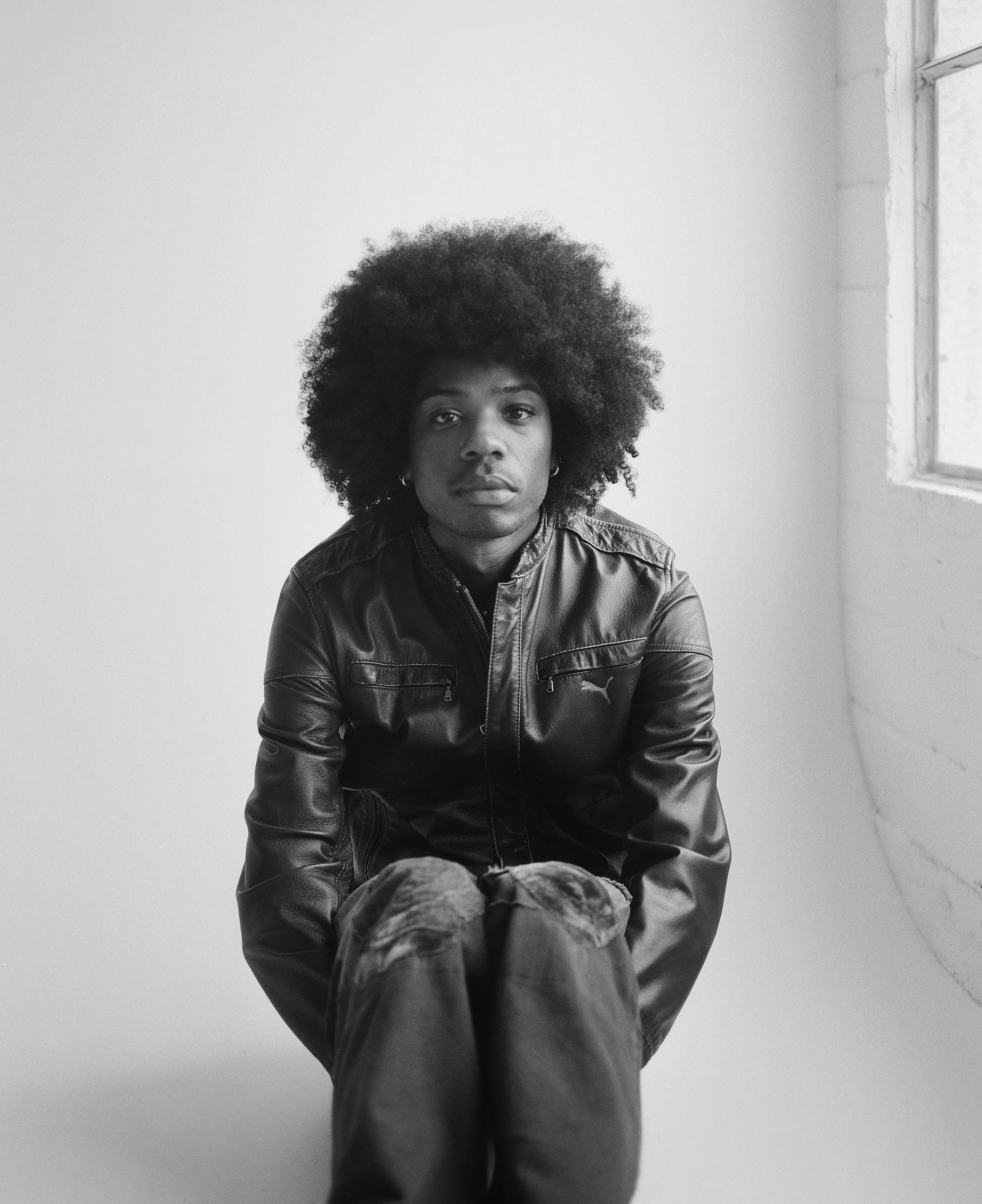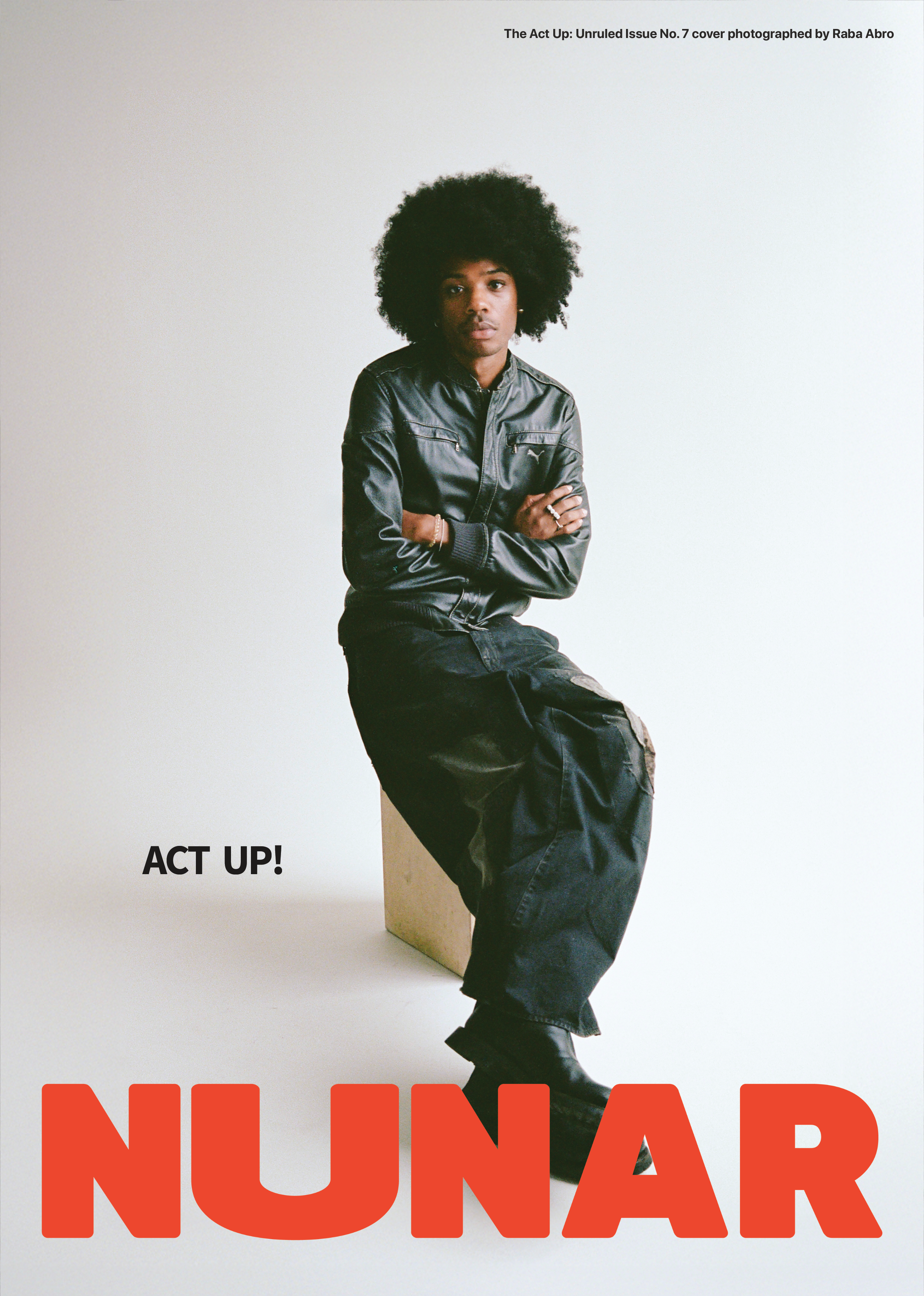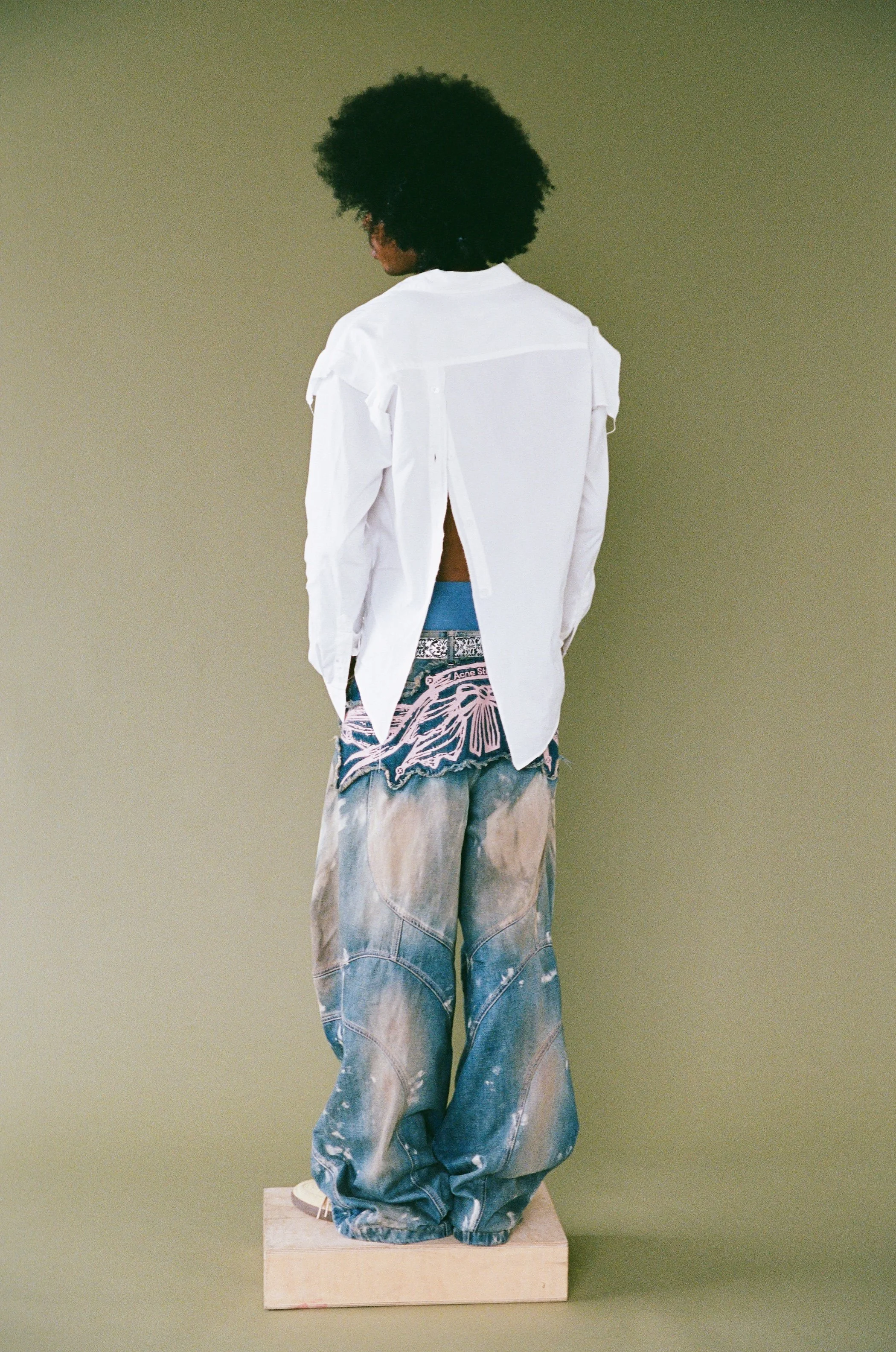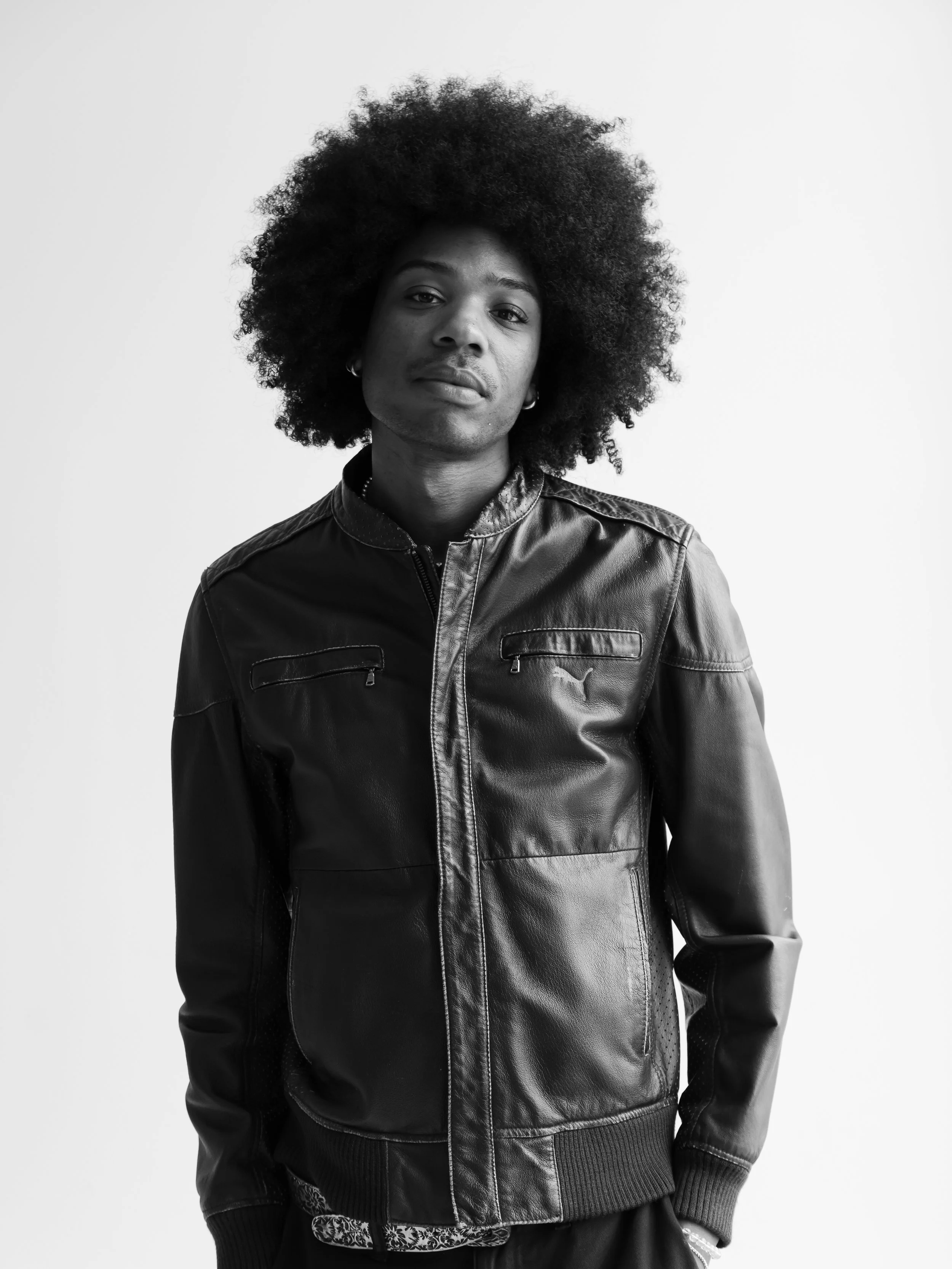Verde Madera Talks Exhale Vol. 1 and Becoming a Kid Again
story by BOLU OLASEINDE, photo by RABA ABRO, fashion by KIKI LONDON
Making art that feels honest, lasting, and deeply personal is a labor of love that takes a special character to fulfill. Especially when you’re in front of a massive audience. But for Verde Madera, artist and creative director, he’s found that staying grounded while navigating the surreal is the journey he’s meant to be on. His debut photobook Exhale Vol. 1 ignites a return to the raw creative impulses of his childhood, offering readers a deeply intimate piece of art shaped by years of transformation, loss, and vision. Composed of photographs taken around the world during his travels on a music tour, Exhale is a memorialization of authenticity. His story is one of tension and tenderness; of growing up; being watched; creating through grief; learning to offer beauty without needing it to be perfect. In a time when beauty is increasingly politicized, and online curation dominates culture, Verde’s work is about resisting polish and reshaping the lens through which we see life.
In this story, we unpack the key moments behind the making of the book, why Verde doesn’t consider himself a photographer, his reflections on amassing a large following, and how time spent in the DMV, LA, and NYC helped shape the artistic honesty at the heart of Exhale.
Bolupe Olaseinde: The way you approach beauty—and memorializing beauty—feels really intentional. But, I hear you don’t consider yourself a photographer. So what is Exhale Vol. 1? Is it a journal?
Verde Madera: You could say that. Yeah, it’s like a visual journal. It started off as just a collection of photos that felt special to me. Every image in there felt... I don’t know, just important. I went through a bunch of photos to figure out which ones I wanted to include, and from the beginning, I knew I didn’t want it to be built around a specific theme. I trusted that the themes would come through once it was all put together. So yeah, I’d definitely call it a visual journal of a particular time in my life, captured on film. It reflects how I see the world, my art, and everything in between.
Bolupe: We’re in a time right now where everything feels really suffocating. It feels like we’re all taking deep breaths but never really getting to exhale, like there’s no reprieve. So was naming the book Exhale intentional?
Verde: No, actually. The idea for the book came really naturally. Usually, when I’m coming up with something, I just go with what feels right. If something doesn’t feel good, then I’ll sit with it a little longer. But this one came together quickly. I actually had this conversation with Damon [Barnes] the first time we talked. The concept started with me wanting to be more pure with my art and less focused on commerce or external validation.
But, I think every creator wants their work to be seen and felt. Since I was a kid, I knew that part of making art is about being received. People can say, “It doesn’t matter,” but the truth is, if your work doesn’t move someone, you didn’t do the job. The whole point is to inspire and to be inspired. Strip away the money, the hustle, the leveraging of skills—it’s really just about that exchange of energy. And that can come in any form.
The name Exhale came from this idea: inhaling is like taking in inspiration, it’s the internal process. And Exhale, the book, is the output. I had been inspired to make something physical. A lot of my work lived only in digital spaces, and I wanted to create something tangible. Something that someone could hold, cherish, and maybe even pass down. Like, this book could outlive me, that idea felt powerful to me. So yeah, inhale was the inspiration, and Exhale is the release. It’s what came out of that time and perspective.
Bolupe: For the past five years, it’s just been consumption, consumption, consumerism. And during this time, there’s also been this big push toward aesthetic conservatism. Like, the red pill movement, the “clean girl” aesthetic. First we thought those things were meant to better society. But now you can kind of see how they’ve just become dog whistles for “we like this certain type of person,” and everybody else is excluded. So how do you navigate making art in a time when beauty feels politicized and even weaponized?
Verde: I think, again, it goes back to what inspires you. For me, I’m actually inspired by the opposite of what we traditionally call beauty. And in a way, that’s more beautiful to me than beauty itself because it’s not curated. It’s that idea that life is beautiful because it’s terrible, and terrible because it’s beautiful. I’m really infatuated with people who might not traditionally be seen as beautiful. Like, someone I see on the street. Maybe it’s something about their face, or how they carry themselves, or just a conversation they’re having, that moment is beautiful to me. That’s what draws me in. So I start there. And I feel like if you’re grounded in that, you can’t be swayed by what’s trending or what’s considered the current “standard.” But the more we lean into what makes us us, the more that other stuff fades. Everything else is just part of living on Earth. I deal with all of it, but I still create as honestly as I can. So who cares what the standard is? Break it. Make a new one.
Bolupe: So when you do street castings, what’s that moment like? When you come up to someone and feel that energy, that spark and you can kind of see in their eyes that they realize, “This guy wants to photograph me because he thinks I’m beautiful.”
Verde: I think compliments are free. That s*** doesn’t cost anything to give. And it might make someone feel good when they walk away, which is great but for me, it’s also just about expression. That’s it. I don’t feel limited in expressing myself anymore. I used to be more shy when I was a kid, but now I actually really enjoy talking to strangers and connecting with people in these different, spontaneous ways.
I've been in all kinds of situations. Sometimes people are excited, like, “Oh s***, yeah, let’s do it.” And sometimes they say no. But honestly, the best moments are when everything is already there—the person, the light, the background, the whole composition—just waiting. It doesn’t need to be in a studio. I see it right there in real time.
The feeling I get is always one of connection. That’s what I’m chasing. I might say something like, “Yo, you look really cool,” or “Your hair looks amazing, can I shoot you right here?” And those photos might not be the most “beautiful” or have the cleanest composition, but I can tell you the exact story behind every single one of them.
Bolupe: So, how do you keep your photos honest in a time where individuality is not being rewarded?
Verde: Well, first, I would say it’s like life being beautiful and terrible, right? Individuality isn’t being rewarded, but there’s always a person who started it. You know, the clones? They’re copying someone. Someone created the trend, someone built a world for people to live in. I’m really fascinated by that.
I’ve been around a few different people who’ve built worlds, and it’s a crazy thing to see in real time. You build a world based purely on your own inspiration—on the things that inspire you. Like Tyler, the Creator. Golf and all these things. These kids are dressing like him because he built a world. And now they live in that world. There are so many avenues to explore through it whether you’re a fan of his clothes, his music, or just him as a person.
And then you’ve got the people who are just... I don’t even know the word for it. But it’s like, the idea is: there’s always an individual. It’s a chain reaction. It doesn’t just happen randomly. Like, Tyler exists because of Pharrell. Pharrell exists because of, I don’t know—Michael Jackson, Teddy Riley—stuff like that. There are always going to be clones.
But how do I keep my photos honest? Again, it’s just by pulling from my inspiration. By looking to be inspired. By feeling. Channeling, in a sense. Just feeling a moment.
I’m the kind of person that really tries to look around and observe because that’s how I find the moments. I don’t find them by not paying attention. I find them by walking or driving around. And I’m in LA, so there’s always s*** happening. Sometimes you let it come to you. Sometimes you seek it. I like to buy art books and photo books—physical things I can hold and take with me. I ended up finding two books. One of them—I think it’s called This Girl or Girl Something—I’m butchering the title, but it was by this photographer who also writes poetry. The book was full of these beautiful poems and stories mixed in with her photos. I thought that was really beautiful, and it made me want to incorporate more of my life into my work.
The other book was a black-and-white photo book by Diane Arbus. That book ended up inspiring what I’m working on now, my next book. She became one of my favorite photographers. I felt a kind of kinship with her style and with what I liked and aspired to do.
So yeah, nothing’s original. Everything is a reference, to some degree even in small forms.
This might be going off-topic, but I think sampling or collage-making is the greatest and most primal form of art. Because that’s what art is—taking things and putting them together. Whether they “go together” or not, you can make something beautiful from that.
Bolupe: Do you feel like there’s a new resistance forming, and are you trying to be a part of it?
Verde: I mean, yeah, definitely. I’m a Black man. I’m always a part of the resistance, and I’m always going to be on the side of the resistance. I kind of have no choice in the matter. Like, if you look at my Instagram right now, I’m doing intentionally unsettling things to prove a point. I’m pretty much doing performance art to showcase how I’ve felt over the past couple years. People are either getting it, or they’re not.
At first, they thought I was mentally ill. People thought I was crashing out. I was also going through a public breakup, so people were aware of that and they took it as me spiraling or something. But I also—again, back to the art element of it—that’s exactly why I did it. Like, I’m getting comments like: “Yo, this is beautiful,” “I feel anxious,” “Are you okay?” “Are you crashing out?” “This guy’s bugging.”
All of that means I won. From an art standpoint, that means I made people feel something. And that’s all I give a f*** about.
I don’t care how it makes you feel. I really don’t. And I think that’s where commerce changes things because commerce makes it so you do care how people feel. You want them to pay. You want them to fund your life, support your work, allow you to do more, or go bigger.
And maybe that’ll change for me to some degree as I grow. But for now, I’m leaning into the purity of my art. This is the type of art I’ve been wanting to do for a long time, and I just didn’t know how. I finally said, “F*** it, I’m just going to do it and take it as it comes.” So even in that way, I feel like I’m resisting and rebelling.
I posted this very unsettling video of me. My skin very dark, my teeth very white, brushing my teeth with the sound of dentist drills and a reverse sample. I turned my phone off after I posted it, because I thought, “People are going to think I’m f***** crazy.”*
When I logged back in and saw all the different reactions, I was fueled by it. I was like, “Yes. More. And more, and more, and more.” And I’ve been doing them consistently.
But going back to the general idea of rebellion and resistance—100%. 100%. Burn everything down. Start over. You know what I mean?
It’ll be f***** up. It’ll be f***** up for a while. Then it’ll be good. Then f***** up again. Then good again.
Bolupe: How did you sequence Volume One? Why did you include certain photos and leave others out? And how does that lead into Volume Two?
Verde: Volume One was really just about photos that felt special to me; some had already been published online, some hadn’t. But they all gave me a feeling. Like a song from your childhood that takes you back. I wanted the book to have that kind of emotional pull.
The structure is based on color theory. It moves from blue to green, then orange, then red. Since it wasn’t a themed book—like trees or Japan or anything—I needed something to tie it all together visually. Color gave it a rhythm.
The foreword helped frame the larger story of how I got into photography, how I got my first camera as a kid, put it away, and then years later in 2019, a friend sent me a film camera. I had no idea how to use it. I learned from YouTube, went to Panama, shot a bunch of film, came back to D.C., and took it to District Camera because I didn’t even know how to unload the film.
When I got the scans back, I was instantly hooked on the feeling of seeing something and capturing it. Volume One is probably 98% film. I shoot more digital now, but the next book will be a mix—still a lot of film, but also some medium format digital.









